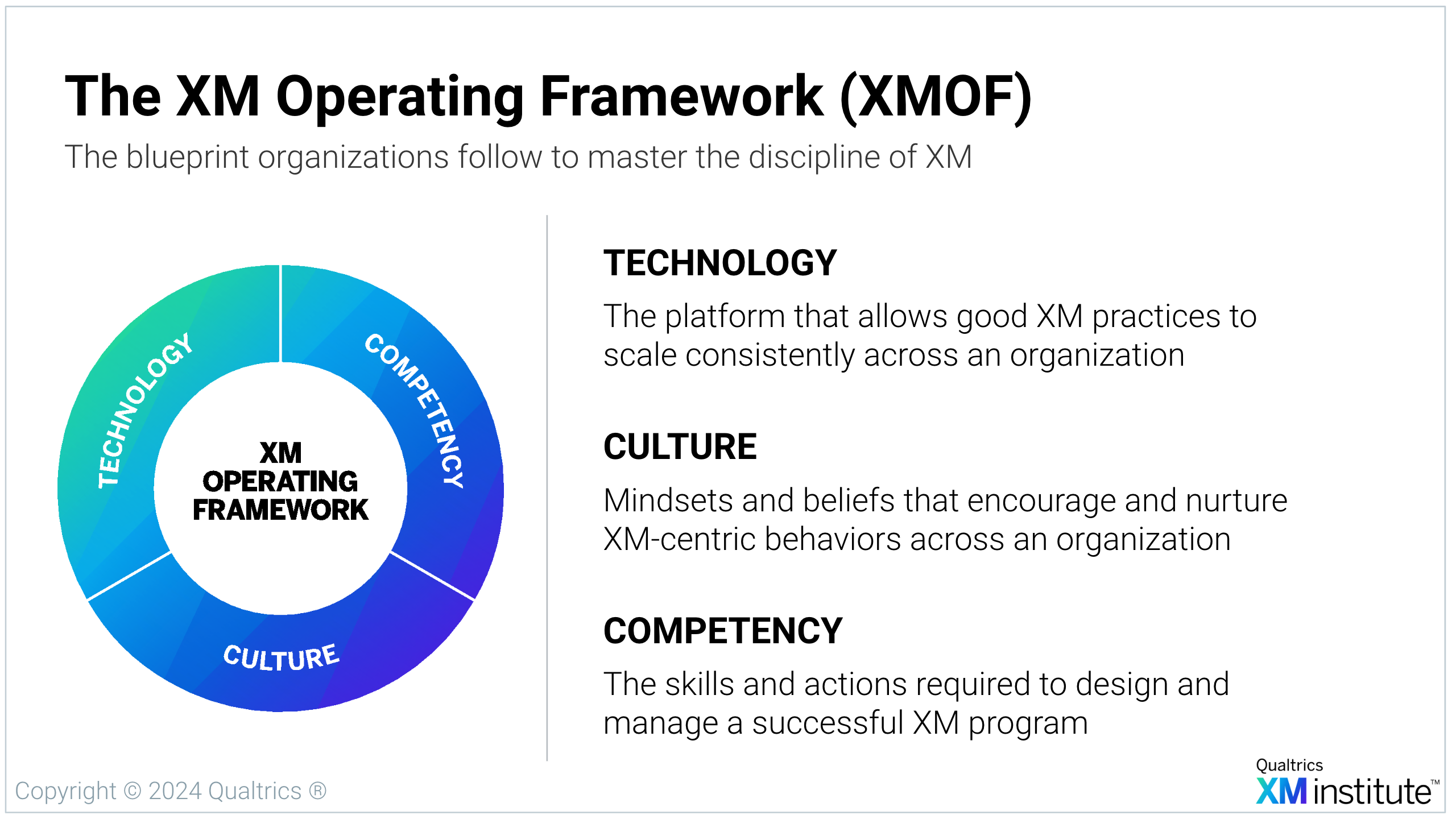This is the first article in XM Institute’s series on XM Technology.
In this post, we will be exploring how Experience Management (XM) can help organizations navigate today’s increasingly uncertain and complex business landscape and examining the Technology component of the XM Operating Framework, which is made up of four pillars: Listen, Understand, Act, and Operate. In the second one, we dive deep into The Technological Capabilities that Power an XM Platform. And in the final article, The Five Levels of Technology Maturity for XM Programs, we look at how these capabilities evolve over time as they progress through five levels of Technology Maturity.
Experience Management (XM) is a Discipline
Organizations today must navigate an increasingly complex and unpredictable landscape. Disruptive technologies are redefining business models. Product life cycles are shrinking, and global economic concerns are rising. Most notably, consumers and employees are becoming more discerning and demanding. To succeed in this rapidly evolving environment, leaders need to rethink how their organizations operate by adopting a more flexible and human-centric approach to doing business.
This requires them to develop a new set of organizational capabilities, one that allows them to continuously sense, interpret, and respond to changes in their environment and deliver on what people actually care about – their experiences. This approach is called Experience Management (XM), which refers to:
the discipline of driving actions based on an ongoing flow of insights about how human beings (e.g., customers, employees, patients, citizens, partners, etc.) are thinking, feeling, and behaving.
The word “discipline” here is both essential and often overlooked. The select organizations that deliver consistent, on-brand experiences – especially across complex ecosystems – do so by virtue of intentionally embedding XM as an organizational habit. These organizations infuse human-centric insights into their decision-making and operating processes across all levels of organization, from executives to frontline employees.
To establish XM as a discipline, an organization should adopt the XM Operating Framework, which is made up of three elements:
- Technology: the platform that allows XM practices to scale consistently across an organization. A powerful XM platform is an essential component of any XM effort as it allows the organization to capture, analyze, and distribute a constant flow of human-centric insights to the relevant people and processes. Without such a platform, XM capabilities and practices cannot scale across the organization.
- Culture: the mindsets and beliefs that encourage and nurture XM-centric behaviors across an organization. An organization’s capacity for change is predicted by the level of internal resistance or support for its XM efforts. Depending on the prevailing mindsets and beliefs, culture can either inhibit the spread of XM-centric behaviors or it can nurture and accelerate their adoption, providing fertile ground for XM Competencies and Technologies to take root and grow. The four attributes of an XM-centric culture are Purpose-Led, Human-Centric, Change-Minded, and Evidence-Based.
- Competency: the skills and actions required to design and manage a successful XM program. To realize value from their XM efforts, organizations need to alter the way they operate in a number of different ways – everything from how they collect and use insights, to how they design experiences, to how they engage leaders and employees in their change efforts. This element is made up of six XM Competencies – Lead, Realize, Activate, Enlighten, Respond, and Disrupt – and their associated 20 Skills. Organizations go about establishing the discipline of Experience Management by mastering this set of Competencies, which are enabled by Technology and nurtured by the organization’s Culture.
By maturing these three XM elements together, organizations build a foundation for agility, innovation, and sustainable success in an era where the human experience is the ultimate differentiator.

The Four Pillars of an XM Technology Platform
Organizations rely on numerous enterprise applications to manage their core operational functions, like finance, HR, and sales. Similarly, to manage people’s experiences at scale, organizations need a dedicated XM Platform capable of monitoring and streamlining relevant XM data and activities. This platform should be deeply embedded into the organization’s operating motions, available to every person and integrated with processes across the business. Without this level of adoption, organizational understanding of experiences will be fragmented and delayed, making it difficult to sustain XM-centric skills, behaviors, and practices at scale.
An XM Platform acts like a central nervous system for Experience Management, enabling the organization to continuously sense and respond to signals from its environment. It provides a unified hub that consolidates all XM data – regardless of its exact form or original source – into a single, accessible repository. Through powerful analytics and AI enhancements, it transforms this raw data into actionable intelligence, which it then delivers to the appropriate people and processes through a variety of highly tailored and timely formats. This intelligence empowers both human decision-making and automated workflows for real-time experience optimization. To fully unlock these competitive advantages, the XM Platform must seamlessly connect with the organization’s existing enterprise systems, such as its CRM or HCM platforms, data warehouses or lakes, and its workflow management tools.
To help organizations understand the capabilities that make up an effective XM Platform, XM Institute has identified four technology pillars, which must work together in concert to be successful:
- Listen: the capability to capture and aggregate XM data about people’s experiences from various touchpoints and channels. Data is the fuel that powers Experience Management, so a robust XM Platform must be able to collect and house the data required to understand people’s experiences, including information about their expectations, perceptions, attitudes, and behaviors. While organizations can collect this information in ad-hoc ways through a variety of technologies, an XM Platform provides a systematic way to identify who to listen to, when to listen, and what to listen for. It enables the design and deployment of a wide variety of listening posts to collect that information, along with access to mechanisms that ensure consistency and controls exist across an organization. By consolidating and standardizing this data, the platform lays the groundwork necessary for meaningful analysis and actions. Important platform capabilities for the Listen pillar include Flexible Collection, Scaled Listening, Experience Database, and AI-Powered Listening.
- Understand: the capability to transform XM data into actionable insights tailored to specific users. An effective XM Platform doesn’t just serve a handful of data analysts; it enables people at all levels of the organization to make quick and informed decisions based on XM insights. To do this, it leverages a suite of analytics capabilities to extract meaningful, actionable intelligence from collected and stored data. It proactively delivers those insights to relevant stakeholders, providing them with timely, role-specific insights that are easy for them to understand and act on. By continually uncovering and sharing XM insights, the platform converts collected data into a strategic asset that empowers every person with the information they need to anticipate and respond to a constantly changing environment. Important platform capabilities for the Understand pillar include Analytics Suite, Role-Based Delivery, Insights Prioritization, and AI-Powered Understanding.
- Act: the capability to drive impactful actions across an organization based on XM insights. An XM Platform is an enabler for organizational and individual improvement, innovation, and initiative. As the volume, velocity, and veracity of XM insights increases, it needs to enable mechanisms for putting this intelligence to use, such as automated workflows that are triggered by data elements and analytics. This can’t happen sporadically; the platform must embed these insights into the organization’s daily operating rhythm by integrating with other business systems and processes. By scaling and enabling XM-centric actions, the platform drives timely and relevant improvements that not only enhance people’s experiences but also increase operational efficiency, leading to better business outcomes for the organization. Important platform capabilities for the Act pillar include Inner-Loop Management, Outer-Loop Management, Action Orchestration, and AI-Powered Actioning.
- Operate: the underlying technical foundation that enables an XM Platform to scale from small feedback programs to complex environments. Like other enterprise applications, an XM Platform must support the scale and performance required by any organization. Most XM data today is scattered across various desktop and departmental systems, which not only limits its value but also poses data security and privacy risks. As organizations mature and expand their Listen, Understand, and Act capabilities, the volume of data, the number of users, and the complexity of integrations increases. The XM Platform provides the core infrastructure, security measures, governance tools, and extensibility that allows it to grow and evolve alongside their XM efforts. By providing the necessary management and controls, the platform ensures the sustainable growth and evolution of the organization’s XM program, enabling it to adapt to changing needs and deliver long-term value. Important platform capabilities for the Operate pillar include Administration & Governance, Security & Compliance, Adaptability & Growth, and AI-Powered Operations.
Here is a brief overview of each pillar’s capabilities and supporting features. For more details, check out the article on The Technological Capabilities that Power an XM Platform:




Bottom Line: To scale and enable XM-centric practices, every organization requires an XM platform with capabilities across four technology pillars: Listen, Understand, Act, and Operate.
Isabelle Zdatny, XMP, CCXP, is Head of Thought Leadership for Qualtrics XM Institute
Dr. Juliana Smith Holterhaus, Ph.D., is a Senior Product XM Scientist with Qualtrics, specializing in Digital XM
Drew Green, XMP, Senior XM Scientist & Global Digital Advisory Lead
Dr. Cecelia Herbert, XMP, PsyD, is a Principal Behavioural Scientist with Qualtrics XM Institute





